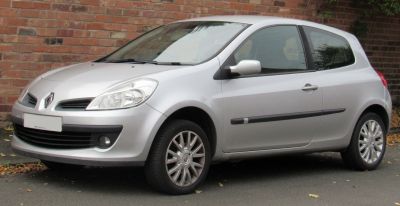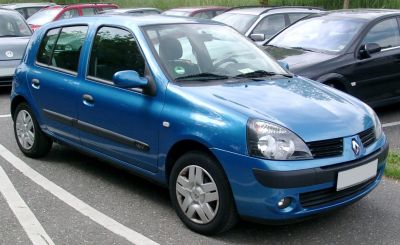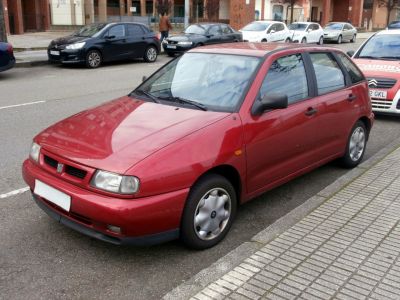 1989 Ford Fiesta III (Mk3) Dimensions, Size & Specs
1989 Ford Fiesta III (Mk3) Dimensions, Size & SpecsMeasurements of the 1989 Ford Fiesta III, engineered for optimal performance and comfort
| Dimensions | |
|---|---|
| Length: | 3743-3769 mm147.4-148.4 in12.3-12.4 ft |
| Width: | 1610 mm63.4 in5.3 ft |
| Height: | 1370-1379 mm53.9-54.3 in4.5-4.5 ft |
| Trunk Capacity: | 250 liter8.8 cu ft |
| Trunk Capacity (Max): | 625 liter22.1 cu ft |
| Weight Specifications | |
| Curb Weight: | 815-990 kg1797-2183 lbs |
| Maximal permitted Weight: | 1275-1425 kg2811-3142 lbs |
| Tire Specifications | |
| Rims Size: |
|
| Tire Sizes: |
|
The Ford Fiesta III, also known as the Mk3, represents the third generation of the popular subcompact hatchback produced by Ford between 1989 and 1995. This generation built on the compact and agile character of the Fiesta, making it a practical choice for urban driving and small families. The Mk3 featured a length ranging from 3743 mm to 3769 mm (147.4 to 148.3 inches), with a width between 1606 mm and 1610 mm (63.2 to 63.4 inches), and a height of 1370 mm to 1379 mm (53.9 to 54.3 inches), placing it firmly in the compact hatchback segment. Weighing between 815 kg and 990 kg (1797 to 2183 lbs), the vehicle maintained a lightweight profile which contributed to its fuel efficiency and nimble handling. The maximum allowable weight varied from 1275 kg to 1425 kg (2812 to 3140 lbs), depending on specific model variations. The luggage compartment offered a practical 250 liters (8.8 cubic feet) of cargo space with rear seats up and expanded significantly to 625 liters (22.1 cubic feet) when the rear seats were folded down, enhancing its versatility for cargo carrying. This generation predominantly came equipped with 13-inch rims, supporting tire sizes such as 155/70 R13, 165/65 R13, 135/80 SR13, and 185/55 R14, balancing comfort and road grip efficiently. Overall, the Ford Fiesta Mk3 continues to be recognized for its compact dimensions, flexible cargo space, and light curb weight, making it a relevant comparison point for those researching small hatchbacks from the late 20th century.
Discover the standout features that make the 1989 Ford Fiesta III a leader in its class
Have a question? Please check our knowledgebase first.
The length of the Ford Fiesta III (Mk3) ranges between 3743 mm and 3769 mm (approximately 147.4 to 148.3 inches). This slight variation depends on specific trims and configurations within the 1989 to 1995 production period. Such a compact length positions the Fiesta III well within the small hatchback category, making it an agile city car ideal for tight urban environments. Its compact dimensions help with parking ease and maneuverability without sacrificing essential cabin space for passengers.
The width of the Ford Fiesta Mk3 ranges between 1606 mm and 1610 mm (approximately 63.2 to 63.4 inches). This relatively narrow width contributes positively to the car’s nimbleness in urban settings, allowing for easier lane shifts and parking in crowded spaces. The width is typical for subcompact hatchbacks of the era, balancing passenger comfort with maneuverability. It ensures the car doesn't feel cramped inside while making it easier to navigate through tight streets and narrow parking spots.
The height of the Ford Fiesta III (Mk3) ranges between 1370 mm and 1379 mm (approximately 53.9 to 54.3 inches). This moderate height provides adequate headroom for most passengers, contributing to a comfortable cabin environment without creating excessive aerodynamic drag or a larger bulky silhouette. The relatively low profile enhances the car's stability and handling dynamics while maintaining a stylish and compact exterior typical of hatchbacks.
The curb weight of the Ford Fiesta III ranges from 815 kg to 990 kg (approximately 1797 to 2183 pounds). This lightweight construction helps the car maintain nimble handling, quick responsiveness, and efficient fuel consumption, particularly beneficial in city driving environments. The lighter weight also impacts the car’s acceleration and braking positively, making it more economical and easier to maneuver compared to heavier vehicles in its class.
The maximum weight (gross vehicle weight) of the Ford Fiesta Mk3 is between 1275 kg and 1425 kg (approximately 2811 to 3140 pounds). This figure includes the vehicle's curb weight plus passengers, cargo, and any additional equipment. Staying within this limit ensures safe driving dynamics and prevents undue stress on the engine, transmission, brakes, and suspension. It's important for users to consider this limit when fully loading the car to maintain optimal performance and safety.
The Ford Fiesta III offers a trunk luggage capacity of 250 liters (about 8.8 cubic feet) with the rear seats in use. When the rear seats are folded down, the luggage capacity expands significantly to 625 liters (around 22.1 cubic feet). This flexibility makes the Fiesta Mk3 practical for everyday tasks like grocery shopping or carrying small cargo, while still allowing for larger items or additional luggage when needed by folding the rear seats flat.
Yes, the Ford Fiesta III fits comfortably into most standard residential garages. With its length ranging from approximately 3743 mm to 3769 mm (147.4 to 148.3 inches) and width between 1606 mm and 1610 mm (63.2 to 63.4 inches), it stays well within common garage dimensions, which typically measure around 2.4 to 3.0 meters wide and over 5 meters long. Its compact size ensures easy maneuvering inside the garage with enough space for entry, exit, and storage around the vehicle.
Compared to the Fiesta II, the Fiesta III Mk3 was slightly larger and heavier, reflecting advancements and evolving market demands for more interior space and safety. The Fiesta III's length ranges from about 3743 mm to 3769 mm, whereas the Fiesta II was generally shorter, with lengths closer to 3600 mm. The width and height also increased marginally, providing more passenger comfort. Additionally, curb weight increased due to added features and structural reinforcements, ranging up to 990 kg compared to the lighter Fiesta II. Overall, these changes made the Fiesta III more practical and safer while maintaining its compact and nimble character.
The Ford Fiesta III held its own among subcompact hatchbacks in the late 1980s and early 1990s, such as the Volkswagen Polo, Opel Corsa, and Peugeot 205. Dimensionally, its length of approximately 3743-3769 mm, width around 1606-1610 mm, and height near 1370-1379 mm were competitive, offering a good balance of maneuverability and interior space. Its 250-liter luggage space (expandable to 625 liters) was fairly typical but practical for the class. Additionally, the light curb weight contributed to fuel efficiency and agile handling. Overall, Fiesta III was recognized for blending everyday usability, compact exterior dimensions, and solid road manners, making it a popular choice in the small hatchback segment.
The Ford Fiesta Mk3 came equipped with 13-inch rims paired with several tire size options, including 155/70 R13, 165/65 R13, 135/80 SR13, and 185/55 R14. The 13-inch wheels were standard and typical for the era’s subcompact cars, designed to offer a balance between ride comfort and handling precision. The tire width and profile variations allowed owners to choose between a softer ride with taller sidewalls or a sportier feel with lower-profile tires. Overall, these tire and rim sizes helped maintain good ground contact and contributed to the car's nimble handling and smooth ride over typical road surfaces.
Discover similar sized cars.

| Production: | 1989-1996 |
|---|---|
| Model Year: | 1989 |
| Length: | 3745-3795 mm147.4-149.4 in |
| Width: | 1575 mm62.0 in |
| Height: | 1330-1390 mm52.4-54.7 in |

| Production: | 2005-2009 |
|---|---|
| Model Year: | 2005 |
| Length: | 3818-3991 mm150.3-157.1 in |
| Width: | 1639-1768 mm64.5-69.6 in |
| Height: | 1417-1484 mm55.8-58.4 in |

| Production: | 2003-2006 |
|---|---|
| Model Year: | 2003 |
| Length: | 3811 mm150.0 in |
| Width: | 1911 mm75.2 in |
| Height: | 1409-1417 mm55.5-55.8 in |

| Production: | 2003-2006 |
|---|---|
| Model Year: | 2003 |
| Length: | 3811 mm150.0 in |
| Width: | 1911 mm75.2 in |
| Height: | 1417 mm55.8 in |

| Production: | 1993-1999 |
|---|---|
| Model Year: | 1993 |
| Length: | 3813-4109 mm150.1-161.8 in |
| Width: | 1640 mm64.6 in |
| Height: | 1408-1422 mm55.4-56.0 in |
